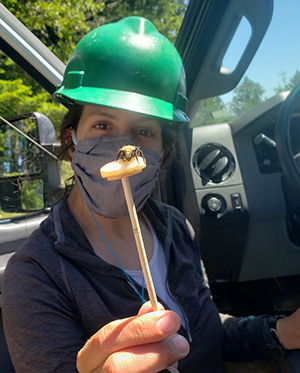
OSU Research Forests student worker Devon Swank recently met with forest ecosystems and society Ph.D. student Rachel Zitomer to learn about some of her research on bumble bee nutritional ecology in the McDonald and Dunn Forests. Rachel is a Ph.D. student within Dr. Jim Rivers’ Forest Animal Ecology lab.
Rachel’s doctoral research examines native bee health in early successional conifer forests. Specifically, Rachel explores how characteristics of timber forest landscapes impact bumble bee health and reproduction across time. “Essentially, this research aims to provide forest managers with information about what flower species are most important for bees and what time of year the flowers are being used”, says Rachel. This information is beneficial when planning for vegetation control and restoration plantings, and can make forest management decisions more bumble bee friendly.
Why do we need pollinators?
Pollinators like bumble bees are responsible for fertilizing most of the world’s flowering plants and play a crucial role in our ecosystems. Pollinators influence our food and agricultural industry, too: wild insect pollinators are estimated to contribute about three billion dollars to the U.S. agriculture industry through pollination every year.
Unfortunately some species of bumble bee, such as the western bumble bee (Bombus occidentalis), once a common species of bumble bee in Oregon, have experienced rapid population decline over the last few decades. These declines can be attributed to a variety of factors, including climate change, pathogens, and impacts from human uses. These varied factors may contribute to bumble bee nutritional stress and decline.
Bumble bee nutritional needs
When bumble bees forage, they collect pollen and nectar by traveling from flower to flower. Nectar provides carbohydrates which fuels movement in adults and provides essential energy. Pollen provides lipids and proteins which are vital to reproduction and the development of young bees.

Pollinators in conifer forests
Generally, bees prefer open habitats with warm ambient temperatures, nesting sites and flowering plants. Given these habitat requirements, research on bees in conifer forests is lacking. This gap in research may be attributed to the fact that conifer forests are typically assumed to be shaded environments with cooler temperatures and few flowering plants. This assumption is certainly accurate for closed-canopy forests. However, there is growing evidence suggesting that bees can be quite abundant in early seral conifer forests.
Early seral forests contain key characteristics that are beneficial for bees, including low canopy cover, warmer understory temperatures, and higher flower counts. Additionally, early seral forests may provide abundant nesting opportunities, but further research is needed in this area.
Ultimately, understanding seasonal changes in bee foraging preferences and nutritional intake in actively managed early seral settings will help land managers better identify what species are most beneficial to bumble bees after a harvest and across planting seasons.
Field sites and data collection
Rachel identified twenty early seral stands in the McDonald and Dunn Forests. These were sites that had been harvested within the last 10 years. At these locations, she measured three aspects of bumble bee foraging across the foraging season (May through August) in 2020 and 2021: 1) The floral preferences of foraging bumble bees; 2) The number of flower species visited by individual bumble bees and by all bumble bees collectively; and 3) The macronutrient ratios (e.g., protein to lipid concentration) of bumble bee-collected pollen.
“We are interested in examining bumble bee nutritional ecology across time because the diversity and density of floral resources changes substantially throughout the foraging season. These seasonal shifts could affect bumble bee foraging behavior and nutrient intake” says Rachel.

What’s next?
Rachel is now analyzing the results and we are eager to write a follow up article with some of the findings! This work is of high importance to the OSU Research Forests and to other forestland managers across the state hoping to conserve and promote habitat and resources for our native bees.
This article originally appeared in the OSU Research Forests newsletter. Thanks to the OSU Research Forests and Devon Swank, OSU Research Forest student communications and outreach assistant, for allowing us to reprint this article. Devon is a senior in the College of Forestry studying natural resource management. Get updates from the OSU Research Forests.

